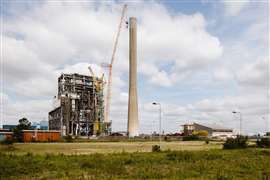Read this article in 中文 Français Deutsch Italiano Português Español
10 new ‘megaprojects’ certified by US Department of Labor
13 May 2024
On 25 April, the US Department of Labor (DOL) announced 16 new megaprojects received Office of Federal Contract Compliance Programs (OFFCP) certification, as 2024 shapes up to be a demanding year in America for infrastructure activity.
Ten novel schemes with a value near or more than US$1 billion join a list of 40 megaprojects designated for direct federal funding or assistance.
The infrastructure projects will be backed by the Biden administration’s US$2 trillion Investing in America agenda, which includes grants and levies allocated from the Inflation Reduction Act (IRA), Infrastructure Investment and Jobs Act (IIJA), and the CHIPS and Science Act.
The projects have been bundled into a programme at OFCCP called the Mega Construction Project (Megaproject) Program. Launched in March 2023, the Megaproject Program “aims to foster equal opportunity in the construction trades’ workforce and expand access to the millions of good jobs being created by large federal or federally assisted construction projects,” according to the DOL.
While several of the projects added to the list are significant in size, the programme’s definition of “megaprojects” is generous. To qualify, builds have to be valued at $35 million or more and that take more than one year to complete.
A list of 10 newest US ‘megaprojects’
The following are ten of the largest and most recently designated megaprojects including project name, project owner, location, cost, and scope, when applicable.
1) Gateway Program: Hudson Tunnel Project Systems and Fit Out – New York and New Jersey
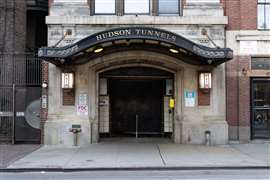 An entrance to the Hudson Tunnel train line in New York City, New York, US. (Image: Adobe Stock)
An entrance to the Hudson Tunnel train line in New York City, New York, US. (Image: Adobe Stock)
The Hudson Tunnel Project rail project, in total, is expected to cost more than $16 billion but has already received $12 billion in federal funding for a scheme that will be funded 70-30 by federal-local partners, respectively.
This leg of construction will include final design and construction of the new Hudson River Tunnel, including renovating the existing 113-year-old North River tunnels. By project end, new tracks will be installed, as well as signals, traction power, ventilation, and fire and safety systems.
The system installation and fit out portion of the project is receiving funding from the US Department of Transportation (DOT) in the amount of $3.8 billion from the Federal-State Partnership (FSP) for Intercity Passenger Rail Grant Program. The Gateway Development Commission is the project owner.
The sprawling project is scheduled to finish around 2035.
2) Brightline West High-Speed Intercity Passenger Rail System – California and Nevada
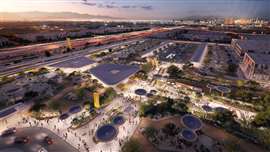 An aerial render of the Las Vegas high-speed rail train station as part of the Vegas-California line currently under construction. (Image: Brightline West)
An aerial render of the Las Vegas high-speed rail train station as part of the Vegas-California line currently under construction. (Image: Brightline West)
The Brightline West rail project, which just recently started construction, is touted as the country’s first ‘true’ high-speed passenger rail system, and it will connect Rancho Cucamonga in the Greater Los Angeles area to Las Vegas, Nevada.
The rail scheme is owned by privately-operated Brightline West in partnership with the Nevada Department of Transportation.
The project was awarded $3 billion from the Infrastructure Investment and Jobs Act (IIJA) and FSP for Intercity Passenger Rail Program, with another $3.5 billion raised by private activity bonds from the US DOT.
Monies will be used for final design, right-of-way acquisition, and construction of 218-miles (350km) of tracks, four stations plus facilities, signal systems, rolling stock, and roadway modifications.
First service is expected in 2028.
3) Penn Station Access – New York
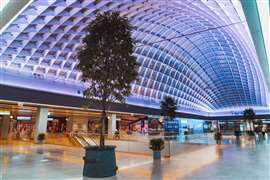 Interior of Penn Station in New York City, New York, US. (Image: Adobe Stock)
Interior of Penn Station in New York City, New York, US. (Image: Adobe Stock)
The New York State Metropolitan Transportation Authority is receiving more than $1 billion from the US DOT’s FSP for Intercity Passenger Rail Grant Program for the Northeast Corridor.
The more than $3 billion project will rehabilitate 19 miles (31km) of the Amtrak-owned Hell Gate Line, which connects New York City’s Penn Station with New Rochelle, New York.
The scheme will upgrade signal systems, as well as provide rehabilitation of four bridges, construction of four new interlockings and five new power substations, upgrades to two existing substations, and overall track rehabilitation. Initial plans for work at Penn Station were announced in March as part of a broader investment by commuter rail company Amtrak.
Construction of the four stations is expected this year, with the project planning to conclude in 2027.
4) Upper Ohio River Navigation – Pennsylvania
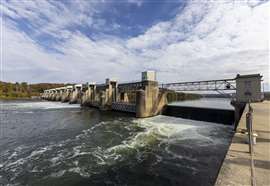 A downstream view of Montgomery Locks and Dam on the Ohio River near Monaca, Pennsylvania, US. (Image: USACE Pittsburgh District | Michel Sauret)
A downstream view of Montgomery Locks and Dam on the Ohio River near Monaca, Pennsylvania, US. (Image: USACE Pittsburgh District | Michel Sauret)
The US Army Corps of Engineers (USACE) is direct-funding as owners – through the IIJA – construction work at Montgomery Lock and Dam on the Ohio River in Allegheny and Beaver counties near the City of Pittsburgh in the Commonwealth of Pennsylvania.
The project will rehabilitate and build new infrastructure for the Montgomery Lock and Dam to address “poor structural condition and inadequate lock capacity for modern navigation tows.”
Initial preparatory contracts were awarded in 2020, with another round in 2023 and general construction contracts expected in 2024.
The entire project, which includes rehabbing two other lock and dam systems in the region, will cost $2.1 billion. The Montgomery Lock and Dam portion of the project is estimated to cost just less than $1 billion.
No estimated completion date was provided for the Montgomery Lock and Dam segment, but the work for the entire scheme (which includes three lock and dam systems) is expected to last until 2050.
5) Raleigh to Richmond Innovating Rail Program Phase IA and II – North Carolina
 Aerial view of Richmond, Virginia, US, with the East Main Street rail station pictured on the left. (Image: Adobe Stock)
Aerial view of Richmond, Virginia, US, with the East Main Street rail station pictured on the left. (Image: Adobe Stock)
While Raleigh waits for its Virginia-based DC connection (read below), the city has its own leg of the rail project underway, as the North Carolina Department of Transportation received assistance from the US DOT’s FSP for Intercity Passenger Rail Grant Program, which will upgrade and put in new track from Raleigh to Wake Forest, North Carolina.
Included in the $1.1 billion of funding is 11 grade separations and closure of multiple at-grade crossings.
The 162-mile (261km) track is estimated to take five to ten years to construct.
6-9) Quartet of regional hydrogen hub projects – Midwest, Appalachia, California and Texas
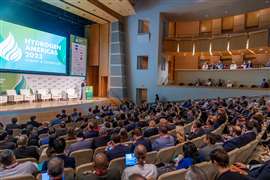 The 2023 Hydrogen Americas Summit held in Washington DC, US. (Image: Hydrogen Americas Summit)
The 2023 Hydrogen Americas Summit held in Washington DC, US. (Image: Hydrogen Americas Summit)
Among the new plans are four hydrogen production projects for four major regions of the country all with federally assisted funding from the US Department of Energy (DOE): the Midwest Alliance for Clean Hydrogen project in Illinois, Indiana, and Michigan (Heartland Hydrogen Hub serving as project owner); HyVelocity Hydrogen Hub in Texas (HyVelocity H2Hub as project owner); Appalachian Hydrogen Hub in Pennsylvania, Ohio, and West Virginia (Appalachian Regional Clean Hydrogen Hub serving as project owner); California Hydrogen Hub in California (Alliance for Renewable Clean Hydrogen Energy Systems serving as project owner).
The Appalachian hub will receive a federal cost share up to $925 million, the Midwest hub up to $1 billion, and the Texas and California hubs $1.2 billion, each.
All four regional hydrogen projects with receive funding from the IIJA to construct hydrogen production facilities.
In total, the Biden administration has allocated approximately $7 billion for US hydrogen production facilities through the IIJA.
No construction start or end dates were provided.
10) Transforming Rail in Virginia Phase 2 – Virginia and Washington DC
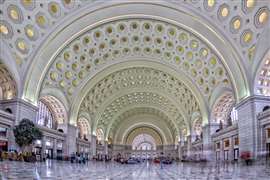 Interior view of Washington DC, US, Union Station (Image: Adobe Stock)
Interior view of Washington DC, US, Union Station (Image: Adobe Stock)
The US DOT is assisting funding of Virginia Passenger Rail Authority (VRPA)’s railway project that seeks to improve track, bridge, and stations along the regional route.
A major portion of the project includes construction of a new Long Bridge over the Potomac River connecting Washington DC with the state of Virginia.
Once complete, the entire megaproject is expected to reduce bottlenecks and extend capacity for travellers in Virginia, Washington DC, and Raleigh, North Carolina.
Phase 2 received $729 million in federally funding for the more than $2 billion project that is expected to finish in 2030.
STAY CONNECTED


Receive the information you need when you need it through our world-leading magazines, newsletters and daily briefings.
CONNECT WITH THE TEAM










